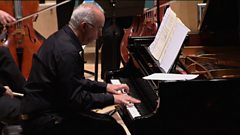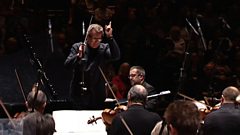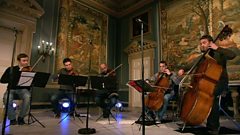Mozart: Symphony No. 39
Charles Hazlewood and the Harmonieband focus on Mozart's Symphony No. 39 in E Flat.
Symphony No. 39 in E flat major, K543 (1788)
1 Adagio – Allegro
2 Andante con moto
3 Menuetto and Trio: Allegretto
4 Finale: Allegro
In the summer of 1788, after supervising the first Viennese production of Don Giovanni, Mozart composed three symphonies in quick succession. Although he was to live another three years, they were to prove his last essays in the form. They must have been intended for a subscription series which he was planning for that year; but as far as we know (the Viennese records are not complete) this never took place. However, Mozart would have had opportunities to perform them on his visits to Leipzig in 1789 and Frankfurt in 1790, in charity concerts in Vienna in 1791, and probably on other occasions as well. The old myth that he never heard them played is unlikely to be true.
Another frequently repeated notion is that the three symphonies were intended as a triptych. If this implies that they were meant to be performed together, the idea is a non-starter: concerts at the time rarely included more than two symphonies, and often even a single work was split into two instalments. But Mozart does seem to have set out to compose three symphonies of completely different and complementary characters, with a view to displaying his range of expression across his proposed concert series, and perhaps subsequently in a published set. And the character of each work is defined largely by his choice of two interrelated elements: key and scoring. No. 40, in G minor and without trumpets and drums, is intense and tragic; No. 41, in C major and without clarinets, is open and brilliant. As for No. 39, it is in the key of E flat major, which for Mozart implied warmth and solidity, even solemnity (in 1791 it was to be the home key of his ‘Masonic’ opera The Magic Flute). And these qualities are matched by the scoring for strings, with cellos and basses frequently separated and violas occasionally divided, and a wind section of flute, two clarinets (the newer instruments replacing the more usual oboes), two bassoons, two horns, and two trumpets with their associated timpani.
The full and warm sound of these instruments in this key is evident at once in the slow introduction, which opens with sonorous dotted rhythms and includes some harsh dissonances before a quiet transition to the Allegro. One other significant feature of this introduction is the sweeping downward scales in the violins, which are echoed (consciously or unconsciously) in the Allegro, and in different forms in the slow movement and the finale. The Allegro itself is in 3/4 time, rather than the more usual 4/4, and after the imposing introduction the combination of this metre and the lyricism of the lightly scored first subject makes the movement seem initially rather slight. Its strength becomes apparent only with the strenuous tuttis which follow both the first theme and the group of ideas which make up the second subject.
Similarly, the A flat major Andante does not reveal all of its character at once: the serene surface presented at the opening is at first merely ruffled by two bars of minor-key colouring, and only then disturbed by a violent outburst in F minor, which later returns even more vehemently in the remote key of B minor.
The trumpets and drums, absent from the second movement, return to add weight to the Minuet. The Trio, in a Ländler rhythm (and apparently based on a traditional dance tune), is dominated by the clarinets, the first demonstrating the instrument’s singing quality while the second plays an accompanying pattern in the low chalumeau register.
The closing Allegro is one of Mozart’s most Haydnesque movements, resembling many of his older friend’s finales in its perpetual-motion energy, with only occasional, telling halts, and in the way all its material is spun out of the opening idea – right up to the witty ending.
Programme note © Anthony Burton
The complete performance is not available for rights reasons.
Duration:
Credits
| Role | Contributor |
|---|---|
| Composer | Wolfgang Amadeus Mozart |
This clip is from
Featured in...
![]()
Discovering Mozart—Composer of the Week
Listen to programmes examining the life and works of Wolfgang Amadeus Mozart.
More clips from Discovering Music
-
![]()
Watch an analysis of Debussy's La mer—Debussy's La mer
Duration: 41:43







